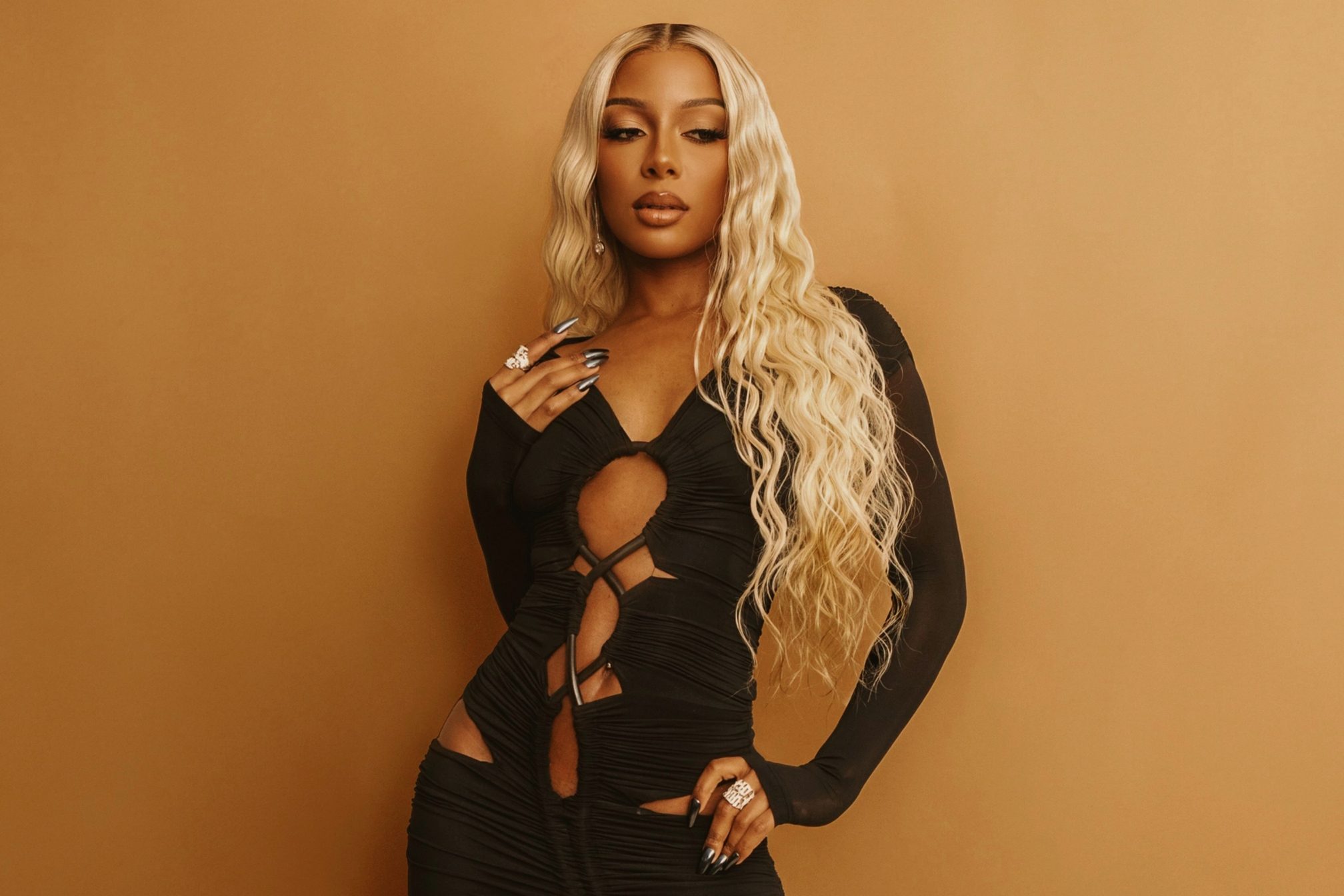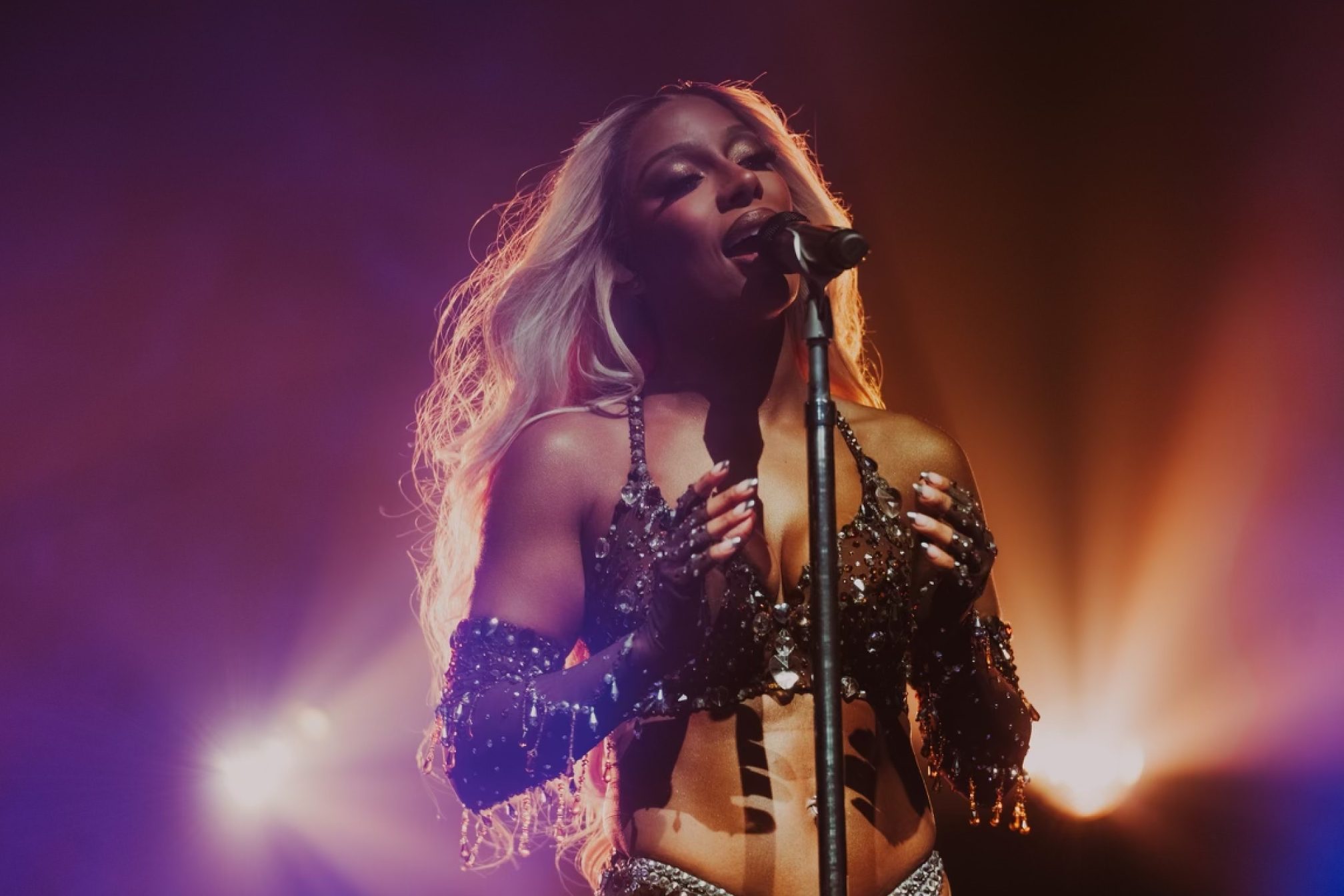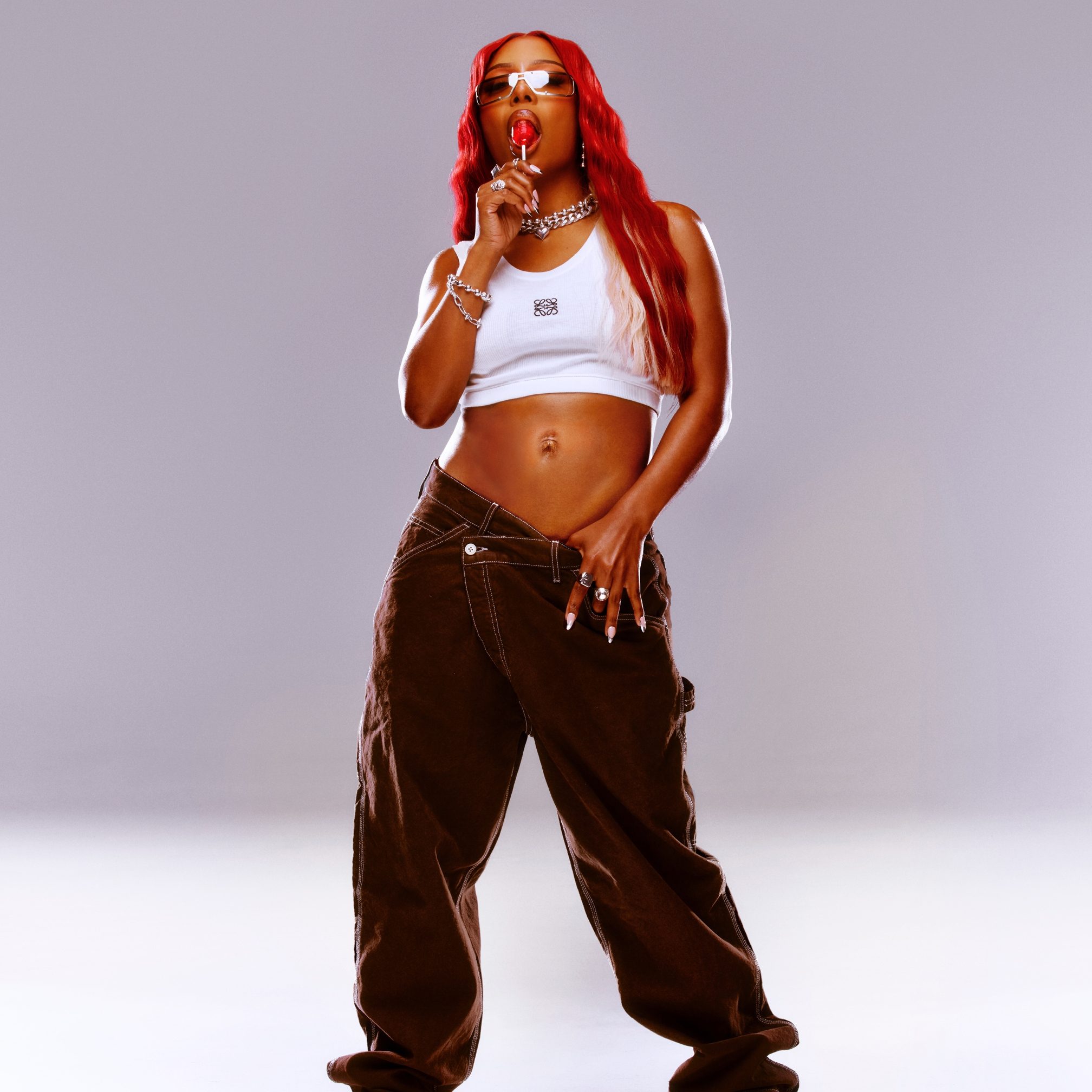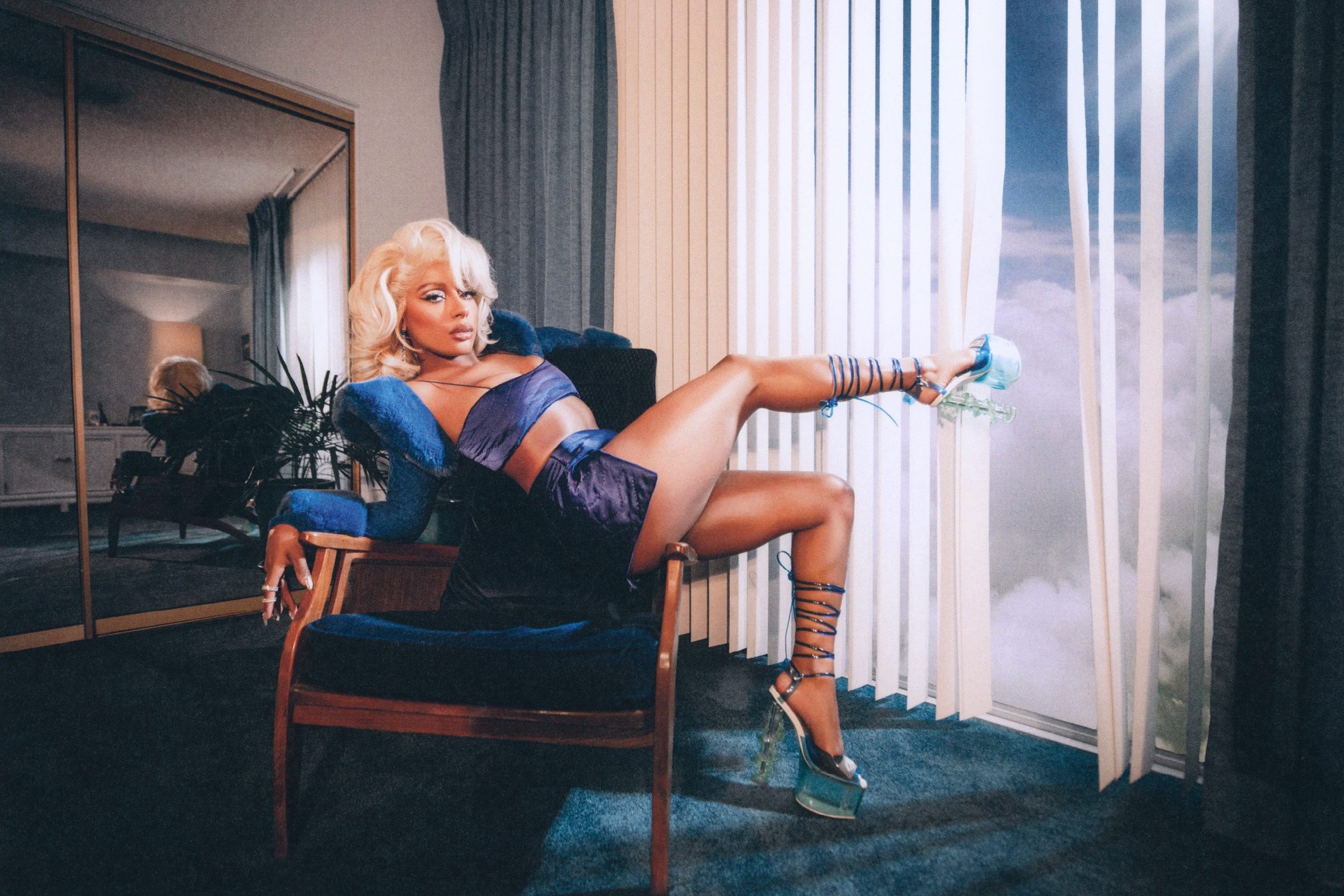 Features
Features
Victoria Monét: The pounce of a global R&B juggernaut
At the close of a year that has seen Victoria Monét bloom into a certified R&B superstar, she speaks to Nicolas-Tyrell Scott about her era-spanning influences and impact on contemporary popular music
A familiar melody is flowing down the stairs and into Sony Music’s UK office reception. Though the newer Kings Cross location can be echoey at times, at mid-afternoon on a Monday in November, the melody engulfs the building's café. It’s soon met by the accompanying lyrics.
“Let’s get wild,” sings events and communications coordinator Jamila Nabukeera, further ad-libbing parts to Victoria Monét’s ‘Jaguar’, the title-track from the inaugural project in her tender and vividly crafted two-part collection of works bearing the same name. There’s excitement in the room for the arrival of Monét, which is still pending. She’s slightly off her three o’clock schedule, but she’s busy, with all eyes now fixated on her. Seven GRAMMY nominations were bestowed on her 72 hours prior, marking one of many breakthroughs across her UK stay.

A monochromatic hue of taupe brown finally glides through the room minutes later, with purpose and command. Still, Victoria Monét feels inviting; both as authoritative as she is courteous. “The idea was warmth. I like the sun, and I like the brown and golden hues,” Monét tells me an hour or so later, during our conversation. Brown at large has become a part of Monét’s entrenched aesthetic for the last four years — it’s now a Jaguar and overall signature, hence the off-bronzed arrival. So much so, that her rapidly growing audience has unofficially, officially instructed attendees to wear the colour across her inaugural Jaguar tour. Beyond building out a bonafide blueprint aesthetically, lies a politic.
“Also feeling underrepresented as a Black woman in music I feel like it made sense, it’s almost like wearing our skin,” she explains, adjusting her custom-made TLZ trench coat. “It’s like a soldier wears uniform. ‘This is us, we’re in here. Pay attention to brown things, pay attention to brown women.’”

Wearing brown has, whether manifested or not, run congruent with Monét’s pounce into the global purview. New to some, she’s been cultivating her identity, sound, and music for over a decade. As she aptly points out, the colour has also followed her career before the Jaguar eras — it forms the backdrop to her cover art for a prior EP-series ‘Life After Love’ and its first edition’s cover art.
“When you put in your 10,000 hours, you just start to gain certain practices as you go on that make you ready for the world. She’s always had that confidence,” asserts Dernst Emile II to me a week later. Known as D’Mile, he has been Monét’s central producer to date, and an R&B, funk and soul architect for the likes of Lucky Daye, Mary J. Blige, and Beyoncé. Living with D’Mile for a period at the top of the last decade, Monét began indenting her arrival into music. From joining Darkchild’s protégé girl group Purple Reign to an eventual pathway into the art form as a songwriter, her diligence paired with determination began stabilising.
Read this next: The Cover Mix: Victoria Monét
“There was a constant learning ethic for her, in her writing,” D’Mile explains. “I know in the beginning she was doing a lot of hooks for artists and rappers.” Monét uses an analogy of sowing seeds to articulate this, as well as many periods in her life. “You wait for some of those to flourish,” she affirms. From Shontelle to Fifth Harmony and T.I., Monét earned credentials as a trusted songwriter, even nominated for GRAMMYs in the early 2020s for it, but diligence in balancing this with her personal musical art persisted. It’s the same diligence that paints our conversation, it’s in the inflections, the waiting to eat until our first, in-person interview is complete, it’s on stage — omnipresent in Monét’s arrival. She’s committed to art first.


In our second interview, her work ethic extends to the prequel to her musical career: dancing. Divulging on movement broadly, she reveals her influences traverse time, including the sometimes androgynous swagger in the late Aaliyah’s form of dance to TLC and Usher’s infectious routines. “I’d never really seen that style of dance before or those elements. But I also felt feminine at the same time. They looked so cool,” she recalls, her deep-brown eyes twinkling as she gets lost in a sea of memories, almost flicking through Aaliyah’s visuals in real-time in her head. Minutes later she calls the ‘King of Pop’ Michael Jackson’s addition to the craft a “trance” to which he had the world in, appreciating the “magic” he brought to the stage. Finding her way to Janet Jackson through the Titan, she also was mesmerised.
After moving from her birth home of Atlanta, Georgia, during her childhood, Monét found herself in Sacramento, California. It was there, aged 12, that she performed for the first time at the Kings basketball team half-time show. “Parents could bring their kids and they could learn a routine for the weekend,” she begins. “We all got to perform at the half-time show and performed it in front of 100 people.” Monét was won over instantly, declaring to her mother that she was “in love” with movement. Learning a variety of dance styles like jazz, ballet, hip hop, and yoga throughout high school, she joined an older dance crew Boogie Monsters, filled with twenty-something-year-olds, to her mother's displeasure.
“Seeing the lifestyle really changed my dynamic and demeanour,” Victoria Monét says, leaning into the passivity in her voice for a moment — almost reflecting a longing for that part of her life again. “It all worked out though,” she says abruptly, her tone heightening with enthusiasm. A producer in the dance group, then under the moniker ‘PC’ (Problem Child), led her to music. She now uses this canvas to convert audiences with her 360-degree offering. Inside the studio, her songs are crafted by beacons like D’Mile, but also utilise her skills as a songwriting extraordinaire. At the front of house, the 'Jaguar' has enthralled her prowl, first across the States, and now in European terrain. Watching her in action 24 hours prior, she is an embodiment of all her training. Neatly packaging her hour-plus Roundhouse debut into a rapid display of dramatised gestures, both simple and more paced alongside her dancer duo, hired for the tour. Veering towards a hybrid of The Supremes, Tina Turner, and The Exciters to more fluidity and placid movement à la ‘Smooth Criminal’ to infusions of bucking, popularised in visuals such as Ciara’s ‘Ride’, Jaguar The Tour provided the platform for Monét to play with dance wholeheartedly and proved enticing in the endurance-fuelled spectacle for just under £40 in a more tumultuous post-pandemic touring climate.

Monét’s timely ascendancy is not only rubber-stamped by guards such as the GRAMMYs, and now The Soul Train Awards, to which she gained her first two wins (Best Dance Performance and Video of the Year) in-between our first and second interviews, but by other tangible markers of success too. After our initial conversation at Sony, while Monét eventually nibbles shyly onto her salad, her stans alert her on Twitter of her latest milestone. A piercing, animated yell is heard from Monét as she declares the news. “Should we announce it yet,” she asks her manager, Rachelle Jean-Lois, coyly. “If the stans say it, it usually comes true.” The news, which is eventually announced hours later, crowns Monét’s current single ‘On My Mama’ as Number One on urban radio on home turf. This adds to the single's Top 50 Hot 100 success in recent months too.
‘On My Mama’ is smartly nostalgic, employing Charlie Boy’s Southern hip hop staple ‘I Look Good’ into the fabrics of its foundations as a sample. This informs the blueprint of the single’s holistic universe, with Monét leaning on her roots in the South to engineer a sonic paean to the Georgia and beyond, in relation to Black culture in neighbouring territories. Ciara again makes an appearance under this manifesto, both in Monét’s red bra-let, cap and half-cut coat and in Ciara’s ‘Goodies’ era leans and dips to the grills and low-hanging T-shirts worn often throughout the 2000s. But beyond that lies the savviness of Monét’s hyper-engaged social presence as contemporary memes, particularly known to Black Twitter, were peppered into the Child. directed ‘On My Mama’ video too, with tact and intuitiveness reflective of her musical ear across both of the Jaguar packages.

“If I could tell you half of the things that went wrong with this video,” Monét says with a wince to her tone. “From scheduling to booking certain things and budget, and changing certain creatives because of that. So many things that were trying us, but I feel like God said ‘You deserve blessings for this one’.” Able to laugh at her situation, she basks in her two Soul Train Award wins for the song, days later with me, grateful to have overcome her trials and tribulations. Extending thanks to the dancers, to Sean Bankhead, the visuals choreographer, she centres the patience that was felt and the “all hands on deck” methodology. Monét’s triumphs aren’t mutually exclusive to just herself. Weeks after her second London show, this time at London’s KOKO, is her peer Coco Jones’ debut UK concert, who she’s written for in her career. Similar to Monét, Jones enjoyed a multi-nomination GRAMMY reception, scoring five listings for her inaugural Def Jam EP ‘What I Didn’t Tell You’ and its breakout hit ‘ICU’, as well as being graced with Best New Artist at the BET headline awards and Soul Train Awards this year. D’Mile points to a shift happening in contemporary R&B. “If you asked me two years ago about ‘ICU’, as great as the song is, I can’t tell if people are going to understand it, but if you told me this 10 or 12 years ago, I would’ve been like ‘that has to be a top joint’,” he shares. “I’m just glad that Coco and Victoria have found the timing to be able to do what they are doing.”
Read this next: Sudan Archives' violin-charged R&B is detonating classical conventions
D’Mile acknowledges the acceptance in new-age R&B that allows for artists he works with like Lucky Daye to be more experimental in their musical process and be “allowed” to display depth. “What’s accepted in R&B is being changed,” he says. Part of this evolution and expansion has seen the likes of SZA dominate on multiple fronts, having one of the most fruitful years in R&B and pop in her career: Her single ‘Snooze’ spent most of 2023 inside of the Hot 100 and er album ‘SOS’ received overwhelming praise for its infusion of rock, pop, hip hop and trap into its R&B-anchored stratosphere.

It’s this room and pliability to the sound across the ’10s and now its triumph in the ’20s that has run adjacent to Monét’s blooming this year — she’s run as both an architect and product of the sounds prosperity, a position that’s equally as impressive as it is unique. Her own offering, the two-part Jaguar series offers consumers a robustly studied array of funk, soul, Motown, R&B, and jazz. Horns in particular are evergreen throughout. From the trumpets and trombone arrangements that grace the ripe and succulent ‘Ass Like That’, alongside the subtle adornment that the flute makes on the provocative and hypnotic dancehall-led ‘Party Girls’, Victoria Monét not only latches onto these particular instruments of choice but fuses them into the fabric of Jaguar’s DNA, making them her own through masterful employment.
“I feel like the flugelhorn tends to be my favourite,” Monét reveals. “But I also love the flute.” Sure to credit flautist Elena Pinderhughes, who graces ‘How Does It Make You Feel’ as well as ‘Party Girls’, she stops in her tracks, making a mental note to let her know she’s nominated for a GRAMMY. “I haven’t spoken to her since before the nomination. I wonder if she knows.” As Monét reconciles her brief moment of innocence and sincerity, she acknowledges one of her deeper influences in British titan Sade: “I feel like Sade sounds like the flute often, like a deep flute in her flow. I want to incorporate that instrument more as I grow.”

Laced amongst Monét’s romantic, triumphant, and sometimes sombre Jaguar messaging is a liberated woman, often presented to audiences in funk-laden packaging. ‘Experience’ and the more recently released, Kaytranada-assisted ‘Alright’ speak to these dimensions to Victoria Monét. The latter has proven so popular that widely speculated demos featuring The Weeknd’s likeness circulated last month across social media. “That’s AI,” she declares, secretly enjoying the fan-generated buzz towards the track (“I like that it’s happening”). A bashful smile beams from cheek to cheek as soon as Kaytranada’s name leaves my lips. ‘Alright’, the Montreal super-producer's sole addition to ‘Jaguar II’, doesn’t just stroll into the ear, it dominates it. Its groove and unorthodox bassline, twangy in its construction, is infectious, compelling, and engulfing as Monét’s credence drives its every move. “I want a whole project with him,” she lets out, unable to contain her joy. Coy, when asked if procedural steps are being made to make that reality, she does let slip that her team “may have” spoken to his. What’s fact though is that a D'Mile and Kaytrananda collaboration exists for Victoria Monét, one that’s uptempo in composition and sharply plotted for ‘Jaguar II’’s deluxe edition. “I do intend on releasing the deluxe, yes,” she states proudly.

If it wasn’t already clear, lineage is important to Monét, as well as the future. It’s littered in what she values, her grace in her coveted wins to date, and in how she trains. She aligns with a more traditional form of training and endurance seen in the superstars of yesteryear, it reflects in her ear (from Buju Banton on ‘Party Girls’ to Earth, Wind & Fire forming part of ‘Jaguar II’’s penultimate number ‘Hollywood’). Hours before our follow-up interview, she was invited to attend another of her influences, Beyoncé’s Renaissance film premiere. On reflection, Monét acknowledges the “ethic” displayed on the screen. “I feel like people as fans need to see it, just to know how much it takes to make such an extravagant experience,” she says. “Just to see her have a 27-year career, you don’t see that a lot.” Part of the Jaguar tour's awe across the first London date was bearing witness to lineage in action. While taking my seat, Janet Jackson discreetly entered general admission seating, with security by her side. Watching the show in its entirety, before congratulating Monét backstage and taking pictures, she bore witness to Monét’s nods to her through her ‘Any Time, Any Place’ to ‘Touch Me’ transition, but also in aspects of her live rendition of ‘Cadillac (A Pimp's Anthem)’ — which she confirms nods both Michael and Janet Jackson signatures. Visibly impressed and taking pictures and videos on her phone throughout, Janet Jackson took to social media to bless and congratulate her.
“I knew FLO were coming,” Monét admits when asked about Janet Jackson, revealing how she’d picked out private seating for the trio. “But my team knew about Janet before. My security said ‘and that’s where Janet’s going to sit’. I was like ‘Janet… Janet Jackson?’” Visibly recoiling at the moment she was told, she recalls being the most nervous she’d ever been for a show. Still, despite the level of hypervisibility that Victoria Monét has been granted, she winced at her routines and having to perform them in front of Janet as a flash of imposter syndrome entered the room. “In some world, what if this is an audition for if I ever got to play her?” she questions innocently. Monét’s worries and admiration are consistent with a tweet she posted eight years ago while watching Janet Jackson receive BET’s first-ever Utimate Icon award and be honoured with a tribute performance. “After we spoke after the show, I replayed that moment so many times in my head, like did I say the right thing?”

Monét’s purity and humanity extend to how she treats her team, hierarchy feels out of place here, where everyone from manager to makeup artist is part of one big collective. She’s quick to demand to still hold her bags (“I wanna feel the heaviness and regret packing so much”), and refuses to let fame change her. But her compassionate politic isn’t in just what she wears, it evolves with reading and learning, and is laid bare in her performances. During her integral part of the show ‘Stop (Askin' Me 4Shyt)’, she instructs her audience in respective tour stops to stop comical or serious behaviours. During her second London show, she demanded that people stop turning a blind eye to genocide (it’s unclear whether she knew about the current conversation around the Renaissance tour visual being shown in Israel).
Outside of the parameters of her adjustment to her soon-to-be A-list environment as a front-facing artist, are her duties as a mother. Now two years old and the youngest GRAMMY-nominee ever, Hazel Monét is heard in the background of our second call. Victoria has been home for less than a week from her Brazil trip to Afropunk Bahia and has been on and off with being able to see Hazel throughout the tour. “Your child doesn’t care about what you do for a living,” she says with a tiredness that consolidates the love, duality, and tension that her vocation brings her between family life and an ‘always-on’ schedule. Monét’s mother, L'Tanya Chestang-Cubit (née Lovett), took six weeks off to support the Jaguar tour — there’s sacrifice across the Lovett bloodline. “My mother and I slept in the same bed, the tour brought us even closer together.” Hazel might not be cognisant of her mother's exact career just yet, but she seems to get closer to the truth moment by moment, year by year. “My lipgloss,” Hazel interrupts in an adamant mumble.
“What does she want, Victoria?” I ask.
“She’s now asking for a brush and now she’s currently doing my makeup and eyeshadow,” Victoria Monét replies, laughing.
It seems, that just like the world, Hazel Monét is clued in that her mother is waiting for her close-up. The Jaguar is ready to feast.
Listen to 'Jaguar II' by Victoria Monét here
Nicolas-Tyrell Scott is a freelance music and culture journalist, writer, critic and podcast host, follow him on Twitter


